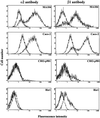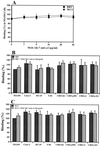VLA-2 (alpha2beta1) integrin promotes rotavirus entry into cells but is not necessary for rotavirus attachment
- PMID: 11773387
- PMCID: PMC135817
- DOI: 10.1128/jvi.76.3.1109-1123.2002
VLA-2 (alpha2beta1) integrin promotes rotavirus entry into cells but is not necessary for rotavirus attachment
Abstract
In an attempt to identify the rotavirus receptor, we tested 46 cell lines of different species and tissue origins for susceptibility to infection by three N-acetyl-neuraminic (sialic) acid (SA)-dependent and five SA-independent rotavirus strains. Susceptibility to SA-dependent or SA-independent rotavirus infection varied depending on the cell line tested and the multiplicity of infection (MOI) used. Cells of renal or intestinal origin and transformed cell lines derived from breast, stomach, bone, or lung were all susceptible to rotavirus infection, indicating a wider host tissue range than previously appreciated. Chinese hamster ovary (CHO), baby hamster kidney (BHK-21), guinea pig colon (GPC-16), rat small intestine (Rie1), and mouse duodenum (MODE-K) cells were found to support only limited rotavirus replication even at MOIs of 100 or 500, but delivery of rotavirus particles into the cytoplasm by lipofection resulted in efficient rotavirus replication. The rotavirus cell attachment protein, the outer capsid spike protein VP4, contains the sequence GDE(A) recognized by the VLA-2 (alpha2beta1) integrin, and to test if VLA-2 is involved in rotavirus attachment and entry, we measured infection in CHO cells that lack VLA-2 and CHO cells transfected with the human alpha2 subunit (CHOalpha2) or with both the human alpha2 and beta1 subunits (CHOalpha2beta1) of VLA-2. Infection by SA-dependent or SA-independent rotavirus strains was 2- to 10-fold more productive in VLA-2-expressing CHO cells than in parental CHO cells, and the increased susceptibility to infection was blocked with anti-VLA-2 antibody. However, the levels of binding of rotavirus to CHO, CHOalpha2, and CHOalpha2beta1 cells were equivalent and were not increased over binding to susceptible monkey kidney (MA104) cells or human colonic adenocarcinoma (Caco-2, HT-29, and T-84) cells, and binding was not blocked by antibody to the human alpha2 subunit. Although the VLA-2 integrin promotes rotavirus infection in CHO cells, it is clear that the VLA-2 integrin alone is not responsible for rotavirus cell attachment and entry. Therefore, VLA-2 is not involved in the initial attachment of rotavirus to cells but may play a role at a postattachment level.
Figures










References
-
- Amadori, M., G. Volpe, P. Defilippi, and C. Berneri. 1997. Phenotypic features of BHK-21 cells used for production of foot-and-mouth disease vaccine. Biologicals 25:65–73. - PubMed
-
- Arias, C. F., C. Guerrero, E. Méndez, S. Zárate, P. Iša, R. Espinosa, P. Romero, and S. López. 2001. Early events of rotavirus infection: the search for the receptor(s). Novartis Found. Symp. 238:47–63. - PubMed
-
- Ball, J. M., P. Tian, C. Q.-Y. Zeng, A. P. Morris, and M. K. Estes. 1996. Age-dependent diarrhea induced by a rotaviral nonstructural glycoprotein. Science 272:101–104. - PubMed
-
- Bass, D., E. Mackow, and H. B. Greenberg. 1991. Identification and partial characterization of a rhesus rotavirus binding glycoprotein on murine enterocytes. Virology 183:602–610. - PubMed
Publication types
MeSH terms
Substances
Grants and funding
LinkOut - more resources
Full Text Sources
Other Literature Sources

